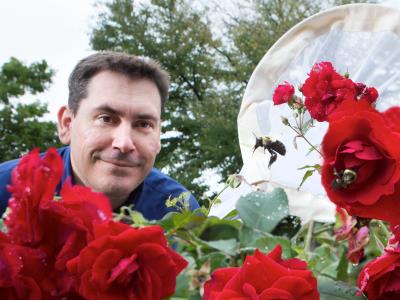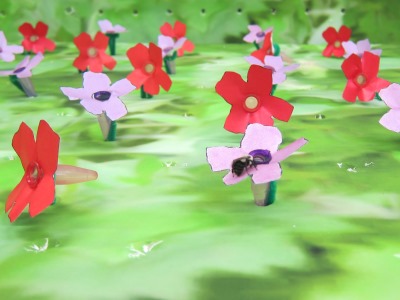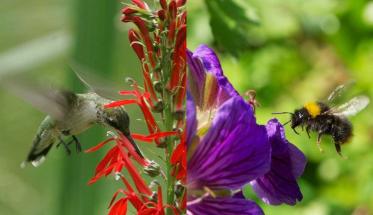Ecologists who study flowering plants have long believed that flowers evolved with particular sets of characteristics—unique combinations of colors, shapes, and orientations, for example—as a means of attracting specific pollinators. But a recent paper in the journal Ecology suggests that flowers that are visited almost exclusively by hummingbirds are actually designed not to lure birds, but to deter bumblebees and their wasteful visits.
The paper, “’Hummingbird’ floral traits interact synergistically to discourage visitation by bumble bee foragers,” demonstrates that traits of so-called “hummingbird flowers” work together to confuse bees and cost them precious time as they move from flower to flower. This extra cost leads most bees to seek nectar rewards from floral alternatives that they can more easily exploit, thus enabling the plants to more effectively attract more efficient hummingbird pollinators.

Robert Gegear gets set to capture wild variants of the
bumblebees he uses in his laboratory studies.
Most hummingbird-pollinated flowers evolved from bee-pollinated ancestors, according to lead author Robert J. Gegear, assistant professor of biology and biotechnology at Worcester Polytechnic Institute (WPI). While the “bee” floral variants tend to be upright and have blue or purple coloration, the “bird” variants have a horizontal orientation and red or orange coloration. Also, bee flowers typically contain small amounts of concentrated nectar, while bird flowers have larger amounts of dilute nectar.
While it has long been thought that the characteristics of bird flowers operate independently to make it difficult for bees to access their nectar (or in the case of the red coloration, to even see the flowers), Gegear’s research shows that, in fact, the traits interact synergistically to encourage bees to look elsewhere for nectar rewards.
In the laboratory, Gegear and his students observed the behavior of foraging bees using arrays of paper flowers that mimicked the blooms of Mimulus lewisii (purple monkey flower), which is pollinated primarily by bumblebees, and a related species, Mimulus cardinalis (scarlet monkey flower), which is pollinated primarily by

Gegear learned about how certain color and orientation
combinations can confuse bumblebees through lab
experiments using paper representations of typical
“bird flowers” (red, horizontal) and “bee flowers”
(lavender, upright).
hummingbirds. They tested three characteristics—color, orientation, and nectar reward—in various combinations.
They found that bees readily visited upright flowers, regardless of their color, as well as lavender flowers, regardless of their orientation. However, when red flowers were placed in the horizontal orientation and lavender flowers were placed in a vertical orientation—mimicking the natural flowers of Mimulus cardinalis and Mimulus lewisii—visits by foraging bumblebees dropped dramatically. Similar effects were observed when red coloration and dilute nectar were combined, showing that floral display and reward traits also interact to discourage bee visitation.
Bumblebees, like most pollinators, are not genetically programmed to visit only particular flowers, Gegear says. They are generalists that seek to maximize their rate of reward intake. But the ideal pollinator, from the plant’s perspective, is one that adopts a specialist foraging strategy, since that will help assure that each plant receives only pollen from its own species. By combining particular floral characteristics, plants manipulate pollinators to become specialists by making generalization a less economically attractive option.
Gegear says his study shows that at least two floral characteristics had to change for the bird flower Mimulus cardinalis to evolve from the bee flower Mimulus lewisii, and that those changes served to discourage bees. To learn why bees avoid the bird flowers, Gegear set up a different experiment in his lab. He first had bees forage on arrays of paper flowers, all of which were of the same color and orientation. Every flower contained a sugar reward. During these runs each bee learned to associate every color and orientation combination with a reward.

